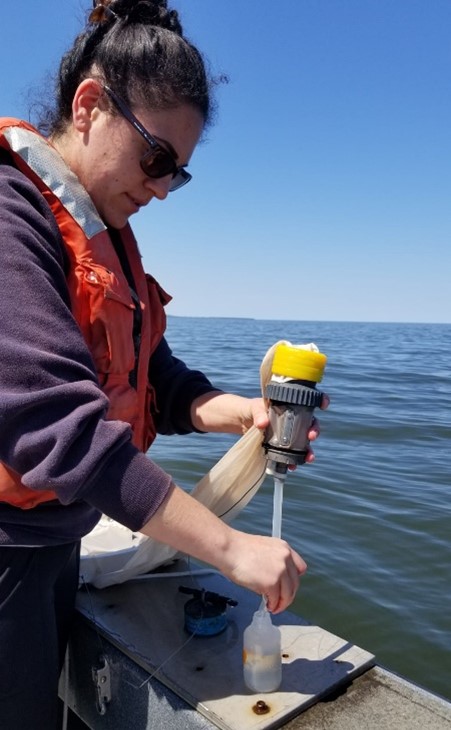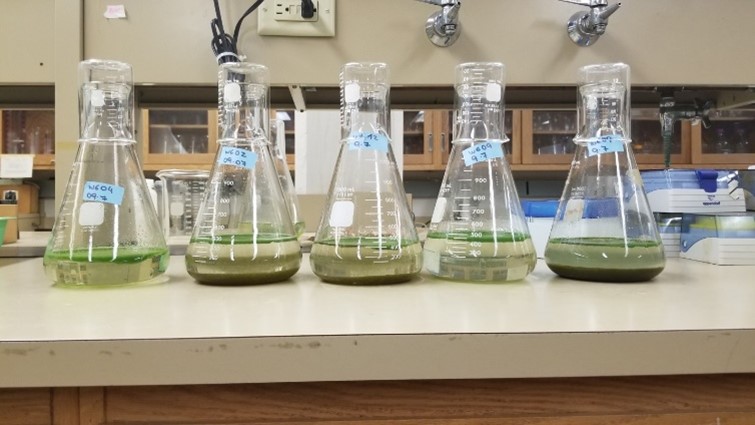July 2024 eNewsletter
Unveiling the Traits of Great Lakes Bloom-Forming Cyanobacteria
.

Carol Waldmann Rosenbaum, 2023-24 CIGLR Graduate Research Fellow.
Harmful algal blooms (HABs) are a major environmental problem that threatens water quality, ecosystem and human health, and coastal communities. The frequency and severity of HABs have increased worldwide, including in the Laurentian Great Lakes, where cyanobacterial harmful algal blooms (cHABs) have been observed in all five lakes. Despite diverse environments, the same bloom-forming taxa are present in all the Great Lakes. While the dominant cyanobacterial species in each bloom vary across lakes and basins from year to year and can change throughout a season, the same five genera are generally present, suggesting that these cyanobacterial genera have adapted to a broad range of conditions.

Carol collecting a phytoplankton tow in Lake Superior’s Mawikwe Bay in 2022.
Carol Waldmann Rosenbaum, a 2023-24 CIGLR Graduate Research Fellow and PhD student at Michigan State University, is working with her advisor Elena Litchman, PhD (Michigan State University) and collaborators Anders Kiledal, PhD (University of Michigan) and Todd Miller, PhD (University of Wisconsin-Milwaukee) to investigate how temperature and nutrient traits vary across and within cyanobacteria populations in the Great Lakes, whether these factors relate to population genetic diversity, and how they contribute to bloom dominance. “During the 2022 and 2023 summers, water samples were collected and received from several locations in Lakes Superior, Michigan, Huron, and Erie and approximately 300 cyanobacteria strains were isolated,” said Waldmann Rosenbaum. “I have been characterizing temperature and nutrient traits for a subset of these strains, including their temperature optima and nutrient quotas and affinities. In addition, Drs. Kiledal and Miller have been analyzing the 16S sequencing and toxicity of the cyanobacteria strains, respectively.”
“So far, our results indicate that Lake Superior’s cyanobacterial population is locally adapted and has lower phosphorus affinity and temperature optima then the cyanobacteria strains from the other Great Lakes,” said Waldmann Rosenbaum. “These results were expected considering the oligotrophic (low phosphorus concentrations) and colder nature of this lake. Additionally, Lake Superior’s cyanobacteria populations seem to be genetically distinct from Lakes Michigan and Erie.”

Water samples collected at different western Lake Erie sampling sites in September 2023. Photo Credit: Carol Waldmann Rosenbaum.
Multi-trait and genomic comparisons between and within the Great Lakes’ cyanobacterial populations will help better define cyanobacterial ecological niches and improve understanding of cHAB drivers. “Results regarding inter- and intraspecific trait variation can help us answer questions such as whether cHABs might become more frequent in locations with sporadic or no blooms; which species or strains will dominate future blooms; and what evolutionary potential under future climatic conditions these strains may have,” said Waldmann Rosenbaum.
“Moreover, the comparison of cyanobacteria strains across lakes facilitates further ecological knowledge integration in the Great Lakes watershed where cHAB study is typically compartmentalized and system-oriented (lake, basin, bay). cHABs are becoming more widespread, and it is imperative that we understand more about their environment and mechanisms for growth and toxicity.”
If you are interested in learning more about Carol’s research, reach out to her at [email protected]
